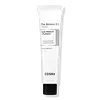What's inside
What's inside
 Key Ingredients
Key Ingredients

 Benefits
Benefits

 Concerns
Concerns

 Ingredients Side-by-side
Ingredients Side-by-side

Water
Skin ConditioningCaprylic/Capric Triglyceride
MaskingPropanediol
SolventGlycerin
HumectantTocopheryl Acetate
AntioxidantCetearyl Alcohol
EmollientButyrospermum Parkii Butter
Skin ConditioningPanthenol
Skin ConditioningTrehalose
HumectantGlycine Soja Oil
EmollientAmmonium Acryloyldimethyltaurate/Vp Copolymer
Dimethicone
EmollientGlyceryl Polymethacrylate
Helianthus Annuus Seed Oil
EmollientPolyglyceryl-10 Stearate
Skin ConditioningHydrogenated Lecithin
EmulsifyingHydroxyethyl Acrylate/Sodium Acryloyldimethyl Taurate Copolymer
Emulsion StabilisingCarbomer
Emulsion StabilisingTromethamine
BufferingGlyceryl Stearate
EmollientPolysilicone-11
Sodium Sulfite
PreservativeTocopherol
AntioxidantDaucus Carota Sativa Root Extract
Skin ConditioningAllantoin
Skin ConditioningGlyceryl Caprylate
EmollientOryza Sativa Bran Wax
Skin ConditioningRetinol
Skin ConditioningTocotrienols
Skin ConditioningStearic Acid
CleansingPolyglyceryl-3 Methylglucose Distearate
EmulsifyingPalmitic Acid
EmollientDisodium EDTA
Ethylhexylglycerin
Skin ConditioningAdenosine
Skin ConditioningSorbitan Isostearate
EmulsifyingElaeis Guineensis Oil
EmollientBHT
AntioxidantBeta-Carotene
Skin ConditioningMyristic Acid
CleansingLauric Acid
Cleansing3-O-Ethyl Ascorbic Acid
Skin ConditioningAscorbic Acid
AntioxidantGlutathione
Limnanthes Alba Seed Oil
Skin ConditioningSodium Hyaluronate
Humectant1,2-Hexanediol
Skin ConditioningHydrolyzed Hyaluronic Acid
HumectantSodium Hyaluronate Crosspolymer
HumectantHyaluronic Acid
HumectantSodium Acetylated Hyaluronate
HumectantWater, Caprylic/Capric Triglyceride, Propanediol, Glycerin, Tocopheryl Acetate, Cetearyl Alcohol, Butyrospermum Parkii Butter, Panthenol, Trehalose, Glycine Soja Oil, Ammonium Acryloyldimethyltaurate/Vp Copolymer, Dimethicone, Glyceryl Polymethacrylate, Helianthus Annuus Seed Oil, Polyglyceryl-10 Stearate, Hydrogenated Lecithin, Hydroxyethyl Acrylate/Sodium Acryloyldimethyl Taurate Copolymer, Carbomer, Tromethamine, Glyceryl Stearate, Polysilicone-11, Sodium Sulfite, Tocopherol, Daucus Carota Sativa Root Extract, Allantoin, Glyceryl Caprylate, Oryza Sativa Bran Wax, Retinol, Tocotrienols, Stearic Acid, Polyglyceryl-3 Methylglucose Distearate, Palmitic Acid, Disodium EDTA, Ethylhexylglycerin, Adenosine, Sorbitan Isostearate, Elaeis Guineensis Oil, BHT, Beta-Carotene, Myristic Acid, Lauric Acid, 3-O-Ethyl Ascorbic Acid, Ascorbic Acid, Glutathione, Limnanthes Alba Seed Oil, Sodium Hyaluronate, 1,2-Hexanediol, Hydrolyzed Hyaluronic Acid, Sodium Hyaluronate Crosspolymer, Hyaluronic Acid, Sodium Acetylated Hyaluronate
Tretinoin 0.05%
Skin ConditioningPolyethylene
AbrasiveGlycol Stearate
EmollientGlyceryl Stearate
EmollientPEG-100 Stearate
Cetyl Alcohol
EmollientStearyl Alcohol
EmollientSqualane
EmollientBHA
AntioxidantBHT
AntioxidantPropylparaben 0.05%
PreservativeStearic Acid
CleansingCarbomer
Emulsion StabilisingGlycerin
HumectantMethylparaben 0.1%
PreservativeDisodium EDTA
Triethanolamine
BufferingIsopropyl Myristate
EmollientSorbic Acid 0.2%
PreservativeWater
Skin Conditioning
 Reviews
Reviews

Alternatives
Ingredients Explained
These ingredients are found in both products.
Ingredients higher up in an ingredient list are typically present in a larger amount.
BHT is a synthetic antioxidant and preservative.
As an antioxidant, it helps your body fight off free-radicals. Free-radicals are molecules that may damage your skin cells.
As a preservative, it is used to stabilize products and prevent them from degrading. Specifically, BHT prevents degradation from oxidation.
The concerns related to BHT come from oral studies; this ingredient is currently allowed for use by both the FDA and EU.
However, it was recently restricted for use in the UK as of April 2024.
Learn more about BHTCarbomer is a polymer of acrylic acid. Its main role is to create a gel consistency.
A high amount of carbomer can cause pilling or balling up of products. Don't worry, most products contain 1% or less of carbomer.
Disodium EDTA plays a role in making products more stable by aiding other preservatives.
It is a chelating agent, meaning it neutralizes metal ions that may be found in a product.
Disodium EDTA is a salt of edetic acid and is found to be safe in cosmetic ingredients.
Learn more about Disodium EDTAGlycerin is already naturally found in your skin. It helps moisturize and protect your skin.
A study from 2016 found glycerin to be more effective as a humectant than AHAs and hyaluronic acid.
As a humectant, it helps the skin stay hydrated by pulling moisture to your skin. The low molecular weight of glycerin allows it to pull moisture into the deeper layers of your skin.
Hydrated skin improves your skin barrier; Your skin barrier helps protect against irritants and bacteria.
Glycerin has also been found to have antimicrobial and antiviral properties. Due to these properties, glycerin is often used in wound and burn treatments.
In cosmetics, glycerin is usually derived from plants such as soybean or palm. However, it can also be sourced from animals, such as tallow or animal fat.
This ingredient is organic, colorless, odorless, and non-toxic.
Glycerin is the name for this ingredient in American English. British English uses Glycerol/Glycerine.
Learn more about GlycerinGlyceryl Stearate is a mix of glycerin and stearic acid.
It is used to stabilize the mixing of water and oil ingredients. By preventing these ingredients from separating, it can help elongate shelf life. It can also help thicken the product's texture.
As an emollient, it helps soften skin and supports barrier-replenishing ingredients.
In cosmetics, Glyceryl Stearate is often made from vegetable oils or synthetically produced.
This ingredient may not be fungal-acne safe
Fun fact: The human body also creates Glyceryl Stearate naturally.
Learn more about Glyceryl StearateStearic Acid is a fatty acid. It is an emollient, emulsifier, and texture enhancer.
As an emollient, stearic acid helps soften skin. It aids the skin's protective barrier by preventing water loss. It also provides a gentle cleansing effect without stripping away natural oils.
Stearic acid may also be used to enhance the texture of products. It can add volume and stabilize ingredients such as water and oil. This can help water and oil ingredients from separating.
Sources of stearic acid include animal or vegetable fats/oils such as coconut or shea. It can be naturally found in butter, cocoa butter, shea butter, vegetable fats, and animal tallow.
This ingredient may not be Malassezia folliculitis, or fungal-acne safe.
Learn more about Stearic AcidWater. It's the most common cosmetic ingredient of all. You'll usually see it at the top of ingredient lists, meaning that it makes up the largest part of the product.
So why is it so popular? Water most often acts as a solvent - this means that it helps dissolve other ingredients into the formulation.
You'll also recognize water as that liquid we all need to stay alive. If you see this, drink a glass of water. Stay hydrated!
Learn more about Water